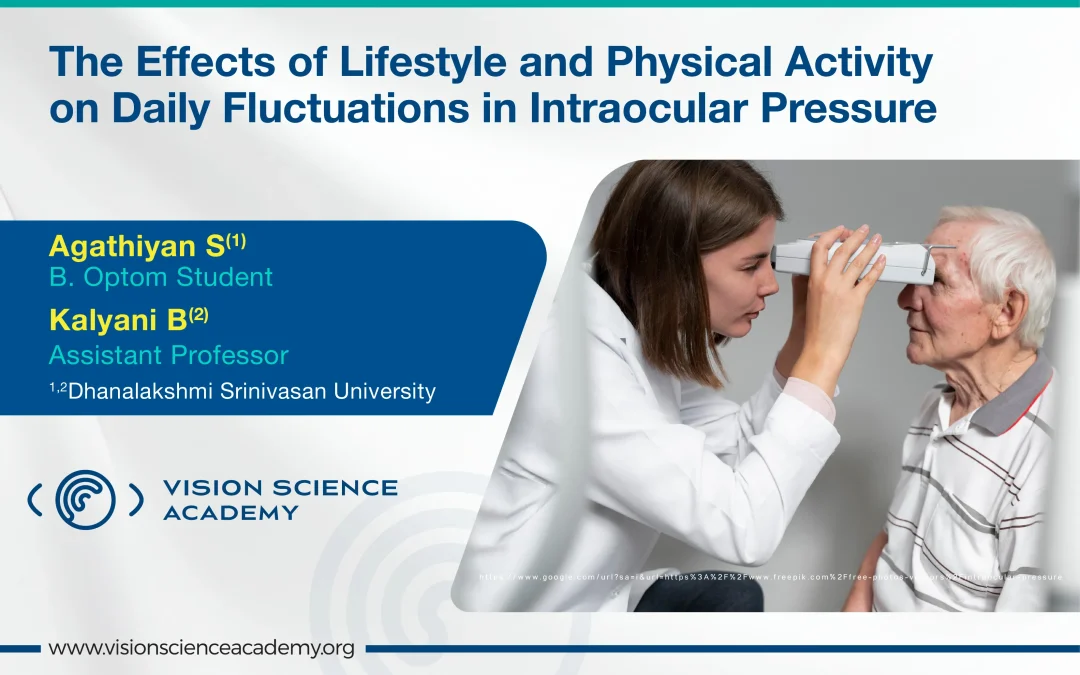Agathiyan S, B. Optom Student; Kalyani B, Assistant Professor
Dhanalakshmi Srinivasan University, Trichy, India
One of the most important factors in preserving eye health is Intraocular Pressure (IOP). It illustrates how the aqueous humour production of the eyes and drainage are balanced. The development and progression of glaucoma, a major cause of permanent blindness globally, are significantly influenced by it. The term “diurnal IOP fluctuation” refers to variations throughout the day. The difference between the 24-hour highest and lowest IOP values is known as intraocular pressure fluctuation. The typical range for normal IOP is 10–20 mmHg. Throughout life, IOP is kept at this level.(1)

Figure 1: Determinants of Daily IOP Variation
The shift in IOP can occur over seconds, days, weeks, or even years. IOP may be influenced by multiple factors, including body position, time of day, and physical activity. For example, IOP can increase when bending over, leaning forward, or lying down. Generally, IOP is lowest in the afternoon and peaks in the early morning hours. Actions such as blinking, rapid eye movements (saccades), and rubbing the eyes can cause short-term fluctuations. Additionally, imbalances between aqueous secretion and drainage may lead to pressure variations. Postural changes and physical activity, including exercise, also affect IOP, while medications such as corticosteroids are known to elevate IOP (Fig. 1). (3)
Lifestyle Factors that Influence Diurnal IOP
- Exercise is a well-established modulator of IOP. Regular aerobic activities, including walking, running, or swimming, have been demonstrated to lower IOP.
- Dietary habits play an important role in IOP management. For example: Caffeine.
- Nocturnal IOP is influenced by body posture during sleeping. Higher IOP readings may result from a side-lying or head-down posture as opposed to an elevated or flat head posture.
- Calm and Stress hormones can affect IOP levels, especially cortisol.
- Drinking alcohol and smoking, while long-term alcohol consumption can cause changes in blood pressure and intraocular pressure, nicotine narrows blood vessels. (4)
Prospects for the Future
- Implantable Sensors: Tiny sensors that are placed inside the eye to continuously measure intraocular pressure.
- Wearable Technology: Wearable technology, including smart contact lenses, can monitor changes in intraocular pressure.
- Gene Therapy: Gene therapy to lower IOP and alter trabecular meshwork function.
- Stem Cell Therapy: This treatment improves IOP management by regenerating trabecular meshwork cells.(5)
Conclusion
Lifestyle and daily activities profoundly influence diurnal IOP fluctuations. From physical activity to dietary habits and stress management, evidence-based lifestyle modifications can complement clinical care in maintaining optimal ocular health. For individuals at risk of glaucoma, these adjustments are not just preventive measures but an essential component of disease management. Future research focusing on personalised lifestyle interventions holds promise for enhancing the quality of life and outcomes for glaucoma patients worldwide. (6)
References
- Michaela, R., Motlagh, M., Zeppieri, M., & Patel, B. C. (2024). Intraocular pressure. In StatPearls [Internet]. StatPearls Publishing.
- Wilensky, J. T. (1991). Diurnal variations in intraocular pressure. Transactions of the American Ophthalmological Society, 89, 757.
- Kim, J. H., & Caprioli, J. (2018). Intraocular pressure fluctuation: Is it important? Journal of Ophthalmic & Vision Research, 13(2), 170.
- Prata, T. S., De Moraes, C. G., Kanadani, F. N., Ritch, R., & Paranhos Jr, A. (2010). Posture-induced intraocular pressure changes: Considerations regarding body position in glaucoma patients. Survey of Ophthalmology, 55(5).
- Yang, C., Huang, X., Li, X., Yang, C., Zhang, T., Wu, Q., … & Xie, X. (2021). Wearable and implantable intraocular pressure biosensors: Recent progress and future prospects. Advanced Science, 8(6), 2002971.
- Grieshaber, M. C., & Flammer, J. (2010). Is the medication used to achieve the target intraocular pressure in glaucoma therapy of relevance?—An exemplary analysis on the basis of two beta-blockers. Progress in Retinal and Eye Research, 29(1), 79–93.


Recent Comments